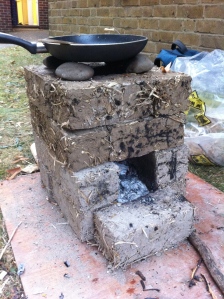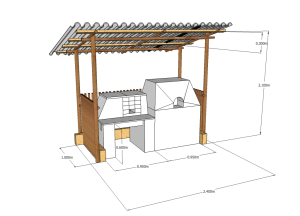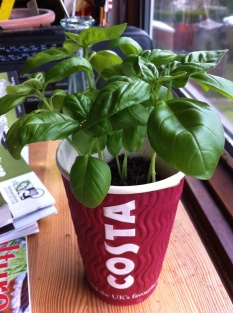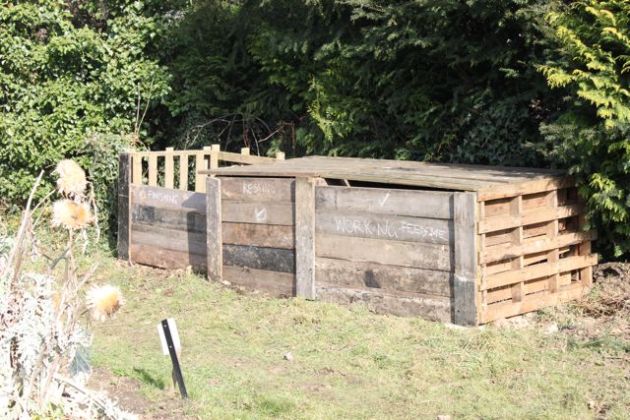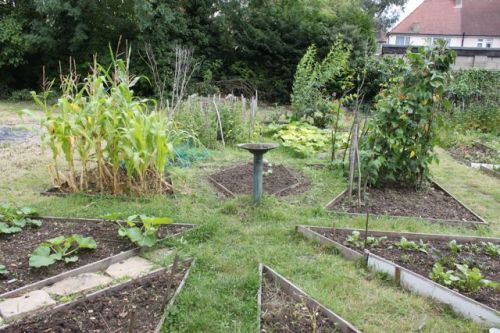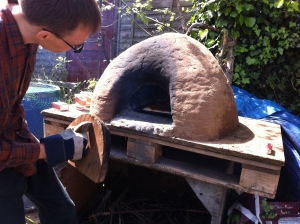
Our Pizza Oven
Back in 2011 members of Ealing Transition built a Clay Oven out of clay and sand at St.Mary’s Church, and used it at our first “Family Re-Skilling Day“. After the event, we* moved it down to Village Park, where it has become the focus of many a community get-together, now otherwise known as a ‘Pizza Day’.
(*) when I say we, I mean the Reverend Steve’s strapping young sons, it weights at least 100kg!
The oven being so successful led us to think of other things we could do to get people together over food, ideally food prepared with at least some of the ingredients grown on the allotment. At Re-skilling Day 2012 I made bricks out of cob (clay, sand and straw) and made a “16-brick rocket stove“. A rocket-stove is a very efficient stove which uses the stack-effect and a controlled amount of air to burn a small amount of fuel hot enough even to fry things on (I made bhajas, a type of spicy gram-flour fritter, a recipe passed into my family by my Mauritian Aunt).
It occurred to us that having a rocket-stove at Village Park would allow us to do other things: fry eggs, make crepes and pan-cakes, more bhajas… so we thought we’d build a more permanent one, and re-arrange the layout of our ‘patio’ area, which has become rather cluttered with all this stuff at the same time!
We started work on a design, which would incorporate the new rocket-stove, the clay-oven and a shelter to keep the worst of the weather off of them. The rocket-stove was to be a combination of a rammed-earth base, and a cob-sculpted top. I measured up, and with Sarah, who’s a whizz at Sketch-up, we made our plans:
Rammed Earth uses natural materials to make sturdy, compressively strong walls and buildings, in our case, using clay and aggregate (they can also me made with chalk, such as the wonderful Calyx Pines building near Dover). The mix is ‘rammed’ hard into the same kind of shuttering used for pouring concrete, but unlike concrete, the technique uses, if not renewable, then at least plentiful materials that can themselves be reused, is relatively low-energy (requires little energy to extract, process and build with the materials), and won’t out-last it’s usefulness, returning to the ground if left exposed to the weather. We’ll be using the rammed-earth to support the weight of the rocket-stove, and it’s cob surround, with two ‘walls’ with space between where we can store wood for the stove.
Cob is an ancient technique, using a clay, sand and straw mixture, which can also be used to build buildings, such as the centuries-old houses still standing in Cornwall, and modern equivalents; it’s not as strong as rammed-earth, but it has the advantage of being ‘plastic’, i.e. it can be moulded to different shapes, allowing organic forms to be created; you’ve probably seen some ornate pizza-ovens around, that’s probably cob decoration. We used some cob to insulate the pizza-oven: another advantage of the material. It’s also low-energy, and straw is a re-newable material, which locks up carbon for as long as the building stands.
The Rocket-Stove will be made using the same technique as the one I made for the Re-skilling day, with cob-bricks, but it will be incorporated into a more permanent cob structure, which will also provide some work-top space.
We started work on the foundations (the least fun bit in my opinion!) in June; the foundations are shallow trenches filled with rubble we collected from the allotment (probably dumped by some unscrupulous builder when the site was derelict, several years ago). The purpose is to isolate the natural materials used in the structure from damp earth, as ingress of water would degrade them, especially with the actions of frost and thaw.
- Foundations Dug
- Rubble ready for filling
- Trimming the Pallet
- New Oven Location
- Foundations Filled
Once the foundations were dug, filled with rubble, and rammed-home, we relocated the pizza-oven to its new home, reducing its pallet base by about a quarter so it didn’t stick-out so much, and reducing the amount of board able to capture rain which then soaks into the pizza-oven. Moving the oven was a bit of a heart-stopping moment, but between six of us, it was a doddle (!).
The next phase is start the rammed-earth base, that’s where the fun starts; we’ll be having a building session on Sunday 22nd July, from 10am; so please join us!
